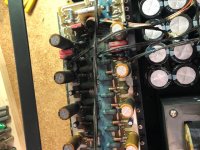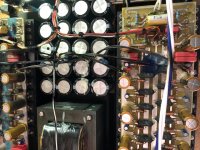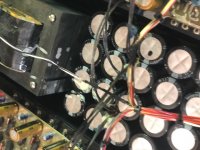Well - this was not fun. Repaired my buddy's AR HD220 Amplifier, it had a blown bridge rectifier - replaced it and got it running, including a glitch with the soft start.
I hooked it up in my system and played it for a half hour or so, left it running, and went down to my shop to work on other stuff. After about another half hour my wife calls me and tells me the amplifier is on fire, literally on fire. Now if you look at the wiring that goes from the capacitor boards to the output stages you can see this is where it started they got red hot and the insulation melted and caught on fire - really why would one use wire like that inside an amplifier ?
It would appear that this was caused by oscillation, perhaps because I had it hooked up via 25 ft long RCA interconnects to a tubed preamp with a relatively high output impedance.
What i find extremely puzzling is that the right side input wire appears to have got real hot as well - or perhaps the wire insulation caught on fire from the hot wires below if - but really - why use wire with insulation that that can do that?
Now this could easily have been avoided with a set of rail fuses to each output stage.
Anyone have any input on this ?
Good Listening
Peter
I hooked it up in my system and played it for a half hour or so, left it running, and went down to my shop to work on other stuff. After about another half hour my wife calls me and tells me the amplifier is on fire, literally on fire. Now if you look at the wiring that goes from the capacitor boards to the output stages you can see this is where it started they got red hot and the insulation melted and caught on fire - really why would one use wire like that inside an amplifier ?
It would appear that this was caused by oscillation, perhaps because I had it hooked up via 25 ft long RCA interconnects to a tubed preamp with a relatively high output impedance.
What i find extremely puzzling is that the right side input wire appears to have got real hot as well - or perhaps the wire insulation caught on fire from the hot wires below if - but really - why use wire with insulation that that can do that?
Now this could easily have been avoided with a set of rail fuses to each output stage.
Anyone have any input on this ?
Good Listening
Peter
Attachments
The manufacturer fitted wires suitable for normal service, which clearly worked fine.
After you "fixed" it there was some sort of overload, which is not the manufacturers fault.
Go back and re-examine what you did to the amp.
After you "fixed" it there was some sort of overload, which is not the manufacturers fault.
Go back and re-examine what you did to the amp.
All the symptoms of high frequency oscillation ,that's some bank of capacitors have you checked the peak current they are capable of ?
And the mains transformer ? --still working no shorted turns (very low voltage output) ?
Pretty pricey repair if done in a professional repair shop.
Read up on --Thermal Cycling in fuses --can introduce distortion this was covered in EW a good while back its one reason many amplifiers use relays or other electronic protection like stabilized power supplies
with safety features.
With that amount of current many resistors will have changed value even the WW varieties.
I agree with Colin.
And the mains transformer ? --still working no shorted turns (very low voltage output) ?
Pretty pricey repair if done in a professional repair shop.
Read up on --Thermal Cycling in fuses --can introduce distortion this was covered in EW a good while back its one reason many amplifiers use relays or other electronic protection like stabilized power supplies
with safety features.
With that amount of current many resistors will have changed value even the WW varieties.
I agree with Colin.
It would appear that this was caused by oscillation, perhaps because I had it hooked up via 25 ft long RCA interconnects to a tubed preamp with a relatively high output impedance.
A tube preamp going into oscillation and feeding the power amp a high frequency, high level signal is certainly a possibility.
Or you were unlucky and one of your replacement caps developed a fault. Never seen this myself but cannot entirely discard the possibility. How do their rated voltages relate to the actual PS voltage?
that's some bank of capacitors have you checked the peak current they are capable of ?
Not sure that is at all relevant. The overcurrent appears to be between the cap bank and the boards that only carry local bypasses, so the current rating of the cap bank is irrelevant. Besides, with so many in parallel, what is the chance the max ripple current can ever be approached?
My guess is that the problem was originally related to failing ThermalTrak output transistors. If the "fix" included bypassing the protection circuit this would definately explain the outcome.
Not sure that is at all relevant. The overcurrent appears to be between the cap bank and the boards that only carry local bypasses, so the current rating of the cap bank is irrelevant. Besides, with so many in parallel, what is the chance the max ripple current can ever be approached?
Are you saying that as a proved fact or surmising,actual down to earth circumstances prove otherwise.
I have re-paired very many power amplifiers gone into oscillation and the current needed to blow up/set on fire/ burn out whole circuit boards came from massive amounts of capacitance .
Ripple has nothing to do with it its the capability of that capacitance to supply large amounts of amps to the circuit when a massive HF oscillation is continuously applied as a signal to the circuit .
Thats actual ,down to earth ,practical surveillance by myself of people who "make adjustments just to see what happens"
My suspicion is an underlying problem was present that took out the bridge rectifier. Second time around it took out the wiring (which may have already been crispy on the inside) Probably oscillates once upto temperature.
The wiring looks underrated for that much capacitance (doesn't this thing have 0.2F of filter cap? (*)). The wiring was the fuse, which is poor design (to say the least).
(*) according to the manufacturer's blurb it has 200000mF !! - but you'd expect that sort of mistake from a marketing department.
The wiring looks underrated for that much capacitance (doesn't this thing have 0.2F of filter cap? (*)). The wiring was the fuse, which is poor design (to say the least).
(*) according to the manufacturer's blurb it has 200000mF !! - but you'd expect that sort of mistake from a marketing department.
a massive HF oscillation is continuously applied as a signal to the circuit .
The topology of this amp leaves about zero chance for oscillations.
On the subject of capacitors and current i have clearly misunderstood your mention of peak current and assumed you meant insufficient max ripple current of the replacements.
So, what does capacitor current have to do with anything? Previously i misunderstood, now i am completely lost 🙂
Last edited:
My suspicion is an underlying problem was present that took out the bridge rectifier.
A great suggestion. The entire mishap had probably nothing to do with the recapping.
A great suggestion. The entire mishap had probably nothing to do with the recapping.
Which recapping are you referring to? Based on the pictures the capacitor bank seems original.
The local caps on the output stage board look like Nichicon FG and i assumed were new, but i may be wrong.
EDIT. I am wrong. Apparently the amp comes with these from the factory
EDIT. I am wrong. Apparently the amp comes with these from the factory
Last edited:
Found 2 references of failing ThermalTraks in AR amps:
Audio Research Experience (moved topic) - General Forum - Audiophile Style
Audiogon Discussion Forum
Audio Research Experience (moved topic) - General Forum - Audiophile Style
Audiogon Discussion Forum
Luckily the circuit, being a simple diamond buffer, is easy to troubleshoot. Perhaps one of the thermaltracks as was previously suggested packed up.
There seems a lesson is to be learned here. After repairing an amp one has to find the underlying cause of failure and check at least that the dc operating points are correct. Replacing a rectifier without doing the rest is not really fixing it.
The topology of this amp leaves about zero chance for oscillations.
On the subject of capacitors and current i have clearly misunderstood your mention of peak current and assumed you meant insufficient max ripple current of the replacements.
So, what does capacitor current have to do with anything? Previously i misunderstood, now i am completely lost 🙂
Did you read the OP,s comment ---after working on it it went on fire .
It doesn't matter if there are 1000 feedback/compensation capacitors that wont stop an amplifier blowing up/going on fire/etc if a fault occurs due a wrong repair or a component failure .
Its obvious not many have repaired burnt out amplifiers .
In my now moderately long experience, I always noticed that power rectifying diodes or bridges are extremely resilient to quite some faults. If a power bridge rectifier failed, it means, there is a fault which causes a very large current to flow beyond the bridge's specifications.
You have to check for conditions which force the amplifier to deliver a heavy current. Self oscillation at a high frequency is one of them. Other conditions include damaged insulation and damaged components because of the heat and unusual current.
In the above, I am assuming, the power rectifier bridge, was sufficiently cooled to work with the right rating.
You have to check for conditions which force the amplifier to deliver a heavy current. Self oscillation at a high frequency is one of them. Other conditions include damaged insulation and damaged components because of the heat and unusual current.
In the above, I am assuming, the power rectifier bridge, was sufficiently cooled to work with the right rating.
Gentlemen,
Firstly - i did not recap the amplifier - all I did was replace a broken bridge rectifier and fix a problem with the soft start. The inrush current limiters was open - in the original design its 4 small 15 Ohm inrush current limiters in parallel in series with a 20W 10 Ohm fixed resistor - i don't like a fixed resistor in a softitart - rater in my own amplifiers I use a inrush current limiter capable of handling it so I replaced it with a 12 Ohm 12A limiter - this is bypassed by a large relay 2 seconds after the start button is switched on - so clearly this has nothing to do with the failure.
The internal wiring is original also.
I remember reading about the Thermal Trac transistors being unstable after a while so probably this could be the underlying issue, however Im still suspicious about the long interconnect.
I have inspected it closer and on the right channel the output transistors are "granaded" open so the problem probably occurred in the right channel probably starting with oscillation rippling back the the left channel causing the wiring to overheat and melt - IMO wiring should not be used as fusing - and if this had a set of rail fuses installed to each channel this would never had happened.
Im still not understanding why the input wiring to the right channel is melted, theres zero current running here under normal operation any input on that ?
Good Listening
Peter
Firstly - i did not recap the amplifier - all I did was replace a broken bridge rectifier and fix a problem with the soft start. The inrush current limiters was open - in the original design its 4 small 15 Ohm inrush current limiters in parallel in series with a 20W 10 Ohm fixed resistor - i don't like a fixed resistor in a softitart - rater in my own amplifiers I use a inrush current limiter capable of handling it so I replaced it with a 12 Ohm 12A limiter - this is bypassed by a large relay 2 seconds after the start button is switched on - so clearly this has nothing to do with the failure.
The internal wiring is original also.
I remember reading about the Thermal Trac transistors being unstable after a while so probably this could be the underlying issue, however Im still suspicious about the long interconnect.
I have inspected it closer and on the right channel the output transistors are "granaded" open so the problem probably occurred in the right channel probably starting with oscillation rippling back the the left channel causing the wiring to overheat and melt - IMO wiring should not be used as fusing - and if this had a set of rail fuses installed to each channel this would never had happened.
Im still not understanding why the input wiring to the right channel is melted, theres zero current running here under normal operation any input on that ?
Good Listening
Peter
According to the schematic the DC protection circuit only triggers the input & output muting relays but does not cut the DC rails to the output BJTs. So some sort of rail fuses would have been helpful. Have you checked that the main fuse is according to the schematic (8 amp MDL)?
It doesn't matter if there are 1000 feedback/compensation capacitors
Тhere aren't any cause there is no feedback. Oscillation is a possibility beyond remote.
- Home
- Amplifiers
- Solid State
- Audio Research HD 220 up in flames



